Beginning woodworking
A question I get asked from time to time is how to get into woodworking,
what tools I would recommend, and where to start.
I can't really make good recommendations as to what specific brands of tools
are better than others.
Most of my tools were opportunistic purchases, with relatively little regard to
specific brands. More often than not, it's price and a quick inspection
to gauge the solidity of the tool that are the determining factors.
My tools are usually not among the best that can be had, but good enough.
Where to start?
But where to start with woodworking? What machines do you need?
My suggestion is that you should start by doing some woodworking, and only
after that start buying big equipment.
I don't mean that entirely literally.
But I think it's best if you buy just a few tools and start using those.
As you get more comfortable with what you have, it becomes easier to
understand what tools you should get next. It also reduces the risk of
buying a workshop full of tools only to find out that you aren't really
into woodworking.
Start by getting a few hand tools - a hammer, screwdrivers, nails, a few chisels,
a hack saw, a try square, some sort of work table, and some clamps.
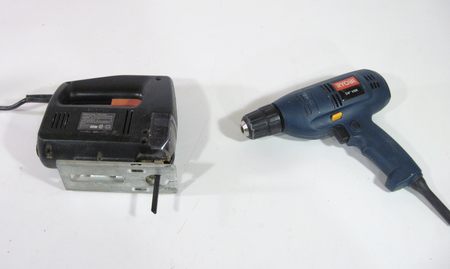
Your first power tools should probably be a drill and a jigsaw. Those are tools
that come in handy here and there, even if you are not into woodworking.
You won't be able to make any fine furniture with them,
but it's enough to bang together a few projects for the basement or outside.
There are different grades of tools available at different prices.
Salesmen will probably tell you to get good quality tools that last a lifetime.
But the price difference between a cheap tool and a good quality tool can easily be
a factor of four. My advice is to get cheap tools first and use them
until they break. Once they break, it's time
to consider getting something better. But unless you are a professional who
uses the tools every day, even a cheap tool is likely to last a long time.
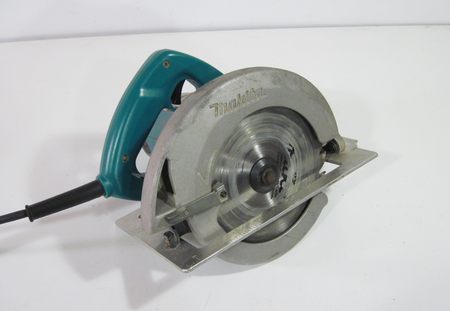
A good tool to get next is some sort of circular saw. A circular saw
cuts a lot faster than a jigsaw, and it's easier to make a straighter cleaner cut
with it. It's also a very useful tool for cutting up big sheets of plywood, even
if you already have a table saw. At this point, you have enough tools for some
simple projects such as this
table or some
storage shelving
You should consider getting a
hand plane
or two at this point, and maybe a workbench
with a vise on it. It may be a good challenge to
build a workbench while you are at it.
With just the tools mentioned above, you can already tackle some basic
projects, such as these:
Getting into stationary machines
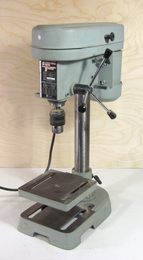
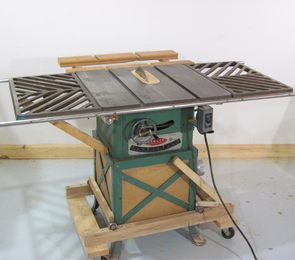
You can get a lot of hand-held power tools, but after getting the assortment
mentioned above, it's probably time to start looking at getting some
stationary tools.
The most useful stationary tools are a drill press and a table saw. For
the longest time, I only had a cheap old contractor saw, and only a very small drill
press, but I made do with those. The difference between a good drill press
and a cheap drill press is much smaller than the difference between a cheap drill
press and no drill press, so don't wait until you can afford the perfect one.
I can't say the same about a table saw. The cheapest benchtop table saws
for under $200 tend to be awful, and will never produce a good clean cut.
The better quality benchtop saws are much better, but cost as much as a contractor
saw will.
A contractor saw is the type of table saw with the motor at the back and open
at the bottom. They tend to be made of cast iron, and good value for the money.
Hybrid saws are also becoming popular. Hybrid saws are essentially built like
contractor saws, but with the motor in the cabinet, just like a cabinetmaker saw.
Those are also good value, but much cheaper than cabinetmakers saws. My present
table saw is a hybrid table saw. The saw depicted at left is a 40-year old contractor
saw, which I enclosed on the bottom to keep the sawdust inside.
To get a cleaner cut, it helps to buy a good quality saw blade for your table saw.
With a decent table saw, and a good quality blade, it should be possible to get
a cut that is clean enough that it should require only minimal work to prepare
it for finishing.
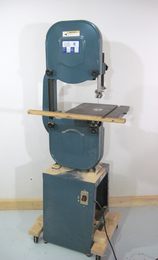
Those tools, plus a bandsaw were all I had when I built my
marble machine one. So you can go quite a ways with just this much equipment.
A nice thing about a bandsaw is that it's not scary to use. Sure, a bandsaw can cut your
fingers off too, but it will probably cut your finger slow enough that you can pull it
back before it's a major injury. I cut into my thumb with a bandsaw once when I was
a kid. I pulled back as soon as I felt it, and the cut on my thumb wasn't even deep
enough to warrant a band-aid. So if table saws scare you, get a bandsaw first.
A bandsaw is also very handy. It cuts cleaner than a jigsaw, but perhaps one of the biggest
advantages of a bandsaw is convenience. It's my tool of choice for making most
quick rough cuts.I also use it for cutting up long scraps to short pieces to fit them in the
scrap box. I really use the bandsaw a lot. I actually bought my bandsaw before
I bought a table saw - I saw one marked down at a woodworking show, and I knew I'd get
one eventually, so I jumped on it. That was before I
built my own
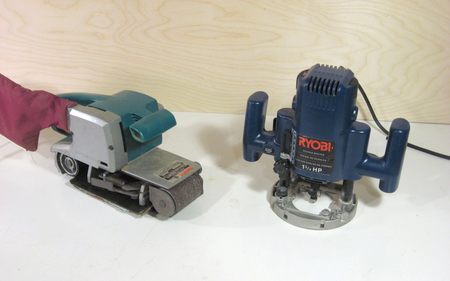
Next it's probably time for some more power tools. A belt sander often comes
in handy. A router is also a really nice thing to have. Don't fret too much
about which router to get - most woodworkers have more than one. So if you don't
like some aspect of your router, it will still be handy as a second router later.
Most people would also recommend that you get some sort of miter saw for
making crosscuts. Personally, I have always just used a
crosscut sled. Miter saws just don't have the rigidity to produce a cut
as clean as can be made with a table saw sled, so I have never been a fan of them.
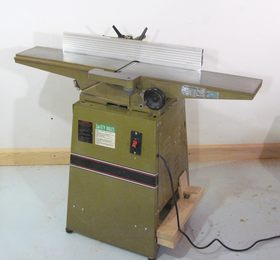
Moving up to the next level, the next machine to get would be a
jointer planer.
A jointer planer is very important if you want to glue up pieces of wood side-by-side
to make panels. It's just plain all around handy for planing stock. I'd recommend
you get a jointer planer before you get a thickness planer, because there is so much
more that can be done with a jointer than a thickness planer. A thickness planer
is really handy to get stock to the right thickness, although in a pinch, that can also
be done on the table saw by putting the workpiece between the fence and the
blade. If you cut from both sides, you can thikness stock up to twice the maximum
depth of cut of your table saw.
Tools that I don't recommend buying
All the tools below have their uses, and you may eventually get to a point where
they are needed. But if you are just starting out, I'd recommend waiting until
later before buying any of the tools below:
Compound sliding miter saw
Hardware stores are full of big compound sliding miter saws. But before you buy one,
ask yourself, how often do you need to cut miters on stock wider than a non sliding
miter saw can handle?
For the few times you have to do that, it's probably better to use a
circular saw. The complicated mechanism of a compound sliding miter saw makes
them less rigid. Which means an expensive compound miter saw may not make as clean
a cut as a non-sliding miter saw for a third of the price.
Do everything combination machines
Avoid machines that can be converted from one machine to another. The ShopSmith
is a prime example of such a machine.
Multi purpose machines are usually good at one or two functions, but other
aspects are compromised. But the real problem is that every time you need to
switch functions, you need to convert the machine.
And the cost of these machines is usually high enough that you
could get several single function machines for the same price.
Workbench
If you want to get into woodworking, a good project to tackle is building your own
workbench. It's really not that hard. So if
building your own workbench is a bit
too much work, or too intimidating, then take a step back and examine whether you
really want to get into woodworking. This may be different if your goal is to
cut silhouettes of kittens out of plywood with a scrollsaw, but I wouldn't
call that sort of activity "woodworking".
Nail gun
Furniture shouldn't use a lot of nails. If you must use nails, you can always
drive them in with a hammer. I am sure you have heard the saying
"if all you have is a hammer, every problem looks like a nail".
Now, if you have a nail gun then... Well, go figure.
Fancy table saw miter gauge and fence
Fancy miter gauges sure look nice, with all the coloured bits of anodized aluminium
and brass knobs. But are those really something you need? Do you really think that
an Incra brand miter gauge made out of bent sheet metal is more trustworthy than the
more solid cast aluminium one that came with your saw? Sorry, but those are some
of my pet peeves. Build yourself a good
table saw sled instead, and you won't need
to second guess it. If you cut a lot of 45-degree miters, make another sled with
a 45 degree angle.
Scrollsaw
Scrollsaws are good for cutesey little projects like cutting puzzles or silhouettes
of cutesey animals out of wood. But for making furniture, scrollsaws just
aren't up to the task.
Scrollsaws, along with Dremel tools, do have their uses in crafts, but for woodworking,
they are just a little too small.
That said, Dremel tools are very useful for sharpening brad point drill bits,
forstner bits, and
bandsaw blades,
so they do have a use in woodworking.
Lathe
You can make nice candle sticks and blows with a lathe. And if your aspiration
is wood turning, a lathe is definitely something you want to invest in. But few
funtiture projects require the use of a lathe. I'm not saying you should never
get a lathe, but a lathe is not one of those "must have" tools like a table saw
or drill press.
Track saw
A track saw will allow you to make many cuts that would otherwise require
a table saw, and is hard to beat if you need to cut up whole sheets of plywood.
But for the price of a track saw, you can buy a table saw, and table saws are
so much more convenient and versatile that a track saw is no substitute.
So if you are just starting out, don't let anybody tell you that you don't
need a table saw if you have a track saw.
 Along with cherry, walnut and oak, maple is considered to be among the
favorite hardwood choices for furniture building. Maple is generally
considered to be strong, durable and very pretty when properly finished.
Along with cherry, walnut and oak, maple is considered to be among the
favorite hardwood choices for furniture building. Maple is generally
considered to be strong, durable and very pretty when properly finished.










 Your first power tools should probably be a drill and a jigsaw. Those are tools
that come in handy here and there, even if you are not into woodworking.
You won't be able to make any fine furniture with them,
but it's enough to bang together a few projects for the basement or outside.
Your first power tools should probably be a drill and a jigsaw. Those are tools
that come in handy here and there, even if you are not into woodworking.
You won't be able to make any fine furniture with them,
but it's enough to bang together a few projects for the basement or outside.
 A good tool to get next is some sort of circular saw. A circular saw
cuts a lot faster than a jigsaw, and it's easier to make a straighter cleaner cut
with it. It's also a very useful tool for cutting up big sheets of plywood, even
if you already have a table saw. At this point, you have enough tools for some
simple projects such as this
A good tool to get next is some sort of circular saw. A circular saw
cuts a lot faster than a jigsaw, and it's easier to make a straighter cleaner cut
with it. It's also a very useful tool for cutting up big sheets of plywood, even
if you already have a table saw. At this point, you have enough tools for some
simple projects such as this 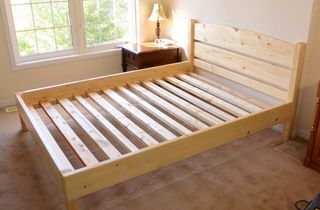
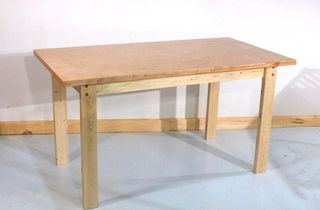
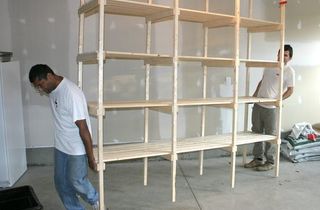
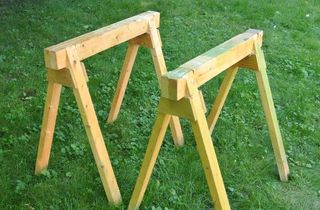

 You can get a lot of hand-held power tools, but after getting the assortment
mentioned above, it's probably time to start looking at getting some
stationary tools.
The most useful stationary tools are a drill press and a table saw. For
the longest time, I only had a cheap old contractor saw, and only a very small drill
press, but I made do with those. The difference between a good drill press
and a cheap drill press is much smaller than the difference between a cheap drill
press and no drill press, so don't wait until you can afford the perfect one.
You can get a lot of hand-held power tools, but after getting the assortment
mentioned above, it's probably time to start looking at getting some
stationary tools.
The most useful stationary tools are a drill press and a table saw. For
the longest time, I only had a cheap old contractor saw, and only a very small drill
press, but I made do with those. The difference between a good drill press
and a cheap drill press is much smaller than the difference between a cheap drill
press and no drill press, so don't wait until you can afford the perfect one.
 Those tools, plus a bandsaw were all I had when I built my
Those tools, plus a bandsaw were all I had when I built my
 Next it's probably time for some more power tools. A belt sander often comes
in handy. A router is also a really nice thing to have. Don't fret too much
about which router to get - most woodworkers have more than one. So if you don't
like some aspect of your router, it will still be handy as a second router later.
Next it's probably time for some more power tools. A belt sander often comes
in handy. A router is also a really nice thing to have. Don't fret too much
about which router to get - most woodworkers have more than one. So if you don't
like some aspect of your router, it will still be handy as a second router later.
 Moving up to the next level, the next machine to get would be a
Moving up to the next level, the next machine to get would be a





